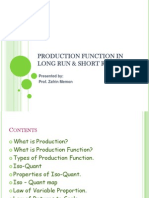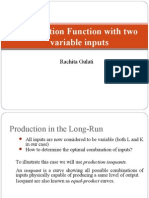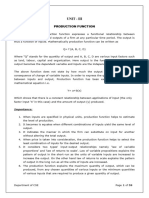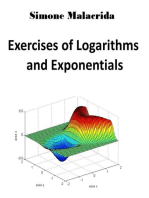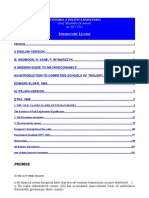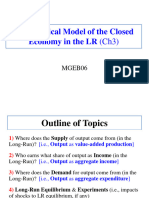Multiple Choice: This Activity Contains 20 Questions
Multiple Choice: This Activity Contains 20 Questions
Uploaded by
mas_999Copyright:
Available Formats
Multiple Choice: This Activity Contains 20 Questions
Multiple Choice: This Activity Contains 20 Questions
Uploaded by
mas_999Original Title
Copyright
Available Formats
Share this document
Did you find this document useful?
Is this content inappropriate?
Copyright:
Available Formats
Multiple Choice: This Activity Contains 20 Questions
Multiple Choice: This Activity Contains 20 Questions
Uploaded by
mas_999Copyright:
Available Formats
Multiple Choice
http://wps.prenhall.com/bp_pindyck_6/19/4991/1277743.cw/content/in...
Home
Chapter 6
Study Guide
Multiple Choice
Multiple Choice
This activity contains 20 questions.
The production decisions of a firm focus on
input choices. production technology. cost constraints. All of the above.
A production function shows
various levels of output associated with specific plant sizes. how to double output by changing the amount of inputs. the highest output that a firm can produce for every specified combination of inputs. combinations of inputs that can be used to produce a given amount of output.
In the theory of the firm, how long does the short run last?
Five years. One month. One year. None of the above.
Suppose that the short-run production function at Skip's Pottery can be represented as Q = 100L L2 where Q is clay pots produced per week and L is the number of hours Skip works per week. If Skip works 40 hours per week, what is his marginal product of labor?
20 40 60 80
Suppose that the short-run production function at Skip's Pottery can be represented as Q = 100L L2 where Q is clay pots produced per week and L is the number of hours Skip works per week. If Skip works 40 hours per week, what is his average product of labor?
20 80 60 40
1 of 5
12/1/2011 12:01 AM
Multiple Choice
http://wps.prenhall.com/bp_pindyck_6/19/4991/1277743.cw/content/in...
If the marginal product of labor is below the average product of labor, it must be true that
the average product of labor is falling. the marginal product of labor is negative. the average product of labor is negative. the marginal product of labor is zero.
The average product of labor is maximized when the marginal product of labor
equals zero. is maximized. equals the average product of labor. None of the above.
As one moves along a convex isoquant, which of the following does not change?
The marginal rate of technical substitution. The level output produced. The capital-labor ratio. The marginal product of labor relative to the marginal product of capital.
A technological improvement
has no impact on the production function. shifts the short-run production function upward. results in a move from one point to another along a short-run production function. changes the shape of the short-run production function.
For the production function, Q = L1/3 K1/3, what shape will the isoquants have?
L shaped. negatively sloped and concave. negatively sloped and convex. negatively sloped straight lines.
The production function, Q = L1/3 K1/3 , exhibits
2 of 5
12/1/2011 12:01 AM
Multiple Choice
http://wps.prenhall.com/bp_pindyck_6/19/4991/1277743.cw/content/in...
constant returns to scale at all levels of production. increasing returns to scale at all levels of production. increasing returns to scale initially, then decreasing returns to scale. decreasing returns to scale at all levels of production.
Labor is measured on the horizontal axis, and capital is measured on the vertical axis. If an isoquant is relatively flat at a certain combination of capital and labor, we know that
there are constant returns to scale. the amount of labor hired is high relative to the amount of capital hired. the marginal product of labor is less than the marginal product of capital. capital and labor must be combined in fixed proportions.
If the isoquants for two different types of inputs are negatively sloped straight lines, then
the two inputs are perfect substitutes for one another. the two inputs are perfect complements for one another. the marginal rate of technical substitution is zero. the marginal productivity of one of the inputs is negative.
If decreasing returns to scale are present, then if all inputs are increased by 10%,
output will increase by more than 10%. output will increase by 10%. output will increase by less than 10%. output will decrease by 10%.
With input combinations (L = 25, K =6), Alma harvested 200 bushels of wheat. After one of the machines broke, she hired more labor. As a result, with input combinations (L = 30, K = 5), she still harvested 200 bushels. One can conclude from these results that
this production function exhibits constant returns to scale. the marginal product of labor is less than the marginal product of capital. the isoquants for this production function are convex. All of the above.
The manager at Skip's Pottery knows the marginal product of labor equals 6 and the marginal product of capital equals 30. Skip will be purchasing one more unit of capital. If the firm wishes to keep the level of output unchanged, then the manager must
3 of 5
12/1/2011 12:01 AM
Multiple Choice
http://wps.prenhall.com/bp_pindyck_6/19/4991/1277743.cw/content/in...
decrease labor hired by 1/5 unit. increase labor hired by 5 units. decrease labor hired by 5 units. increase labor hired by 1/5 unit.
A production function can be written as Q = F(L,K). After various combinations of inputs were used, the following results were obtained: 1000 = F(120,6) 2000 = F(200,10) 3000 = F(300,15) 4000 = F(400,20) 5000 = F(500, 25) 6000 = F(700,35). Over which range of output are there constant returns to scale?
The entire range. 1000 to 3000 units of output only. 4000 to 6000 units of output only. 2000 to 5000 units of output only.
A production function can be written as Q = F(L,K). After various combinations of inputs were used, the following results were obtained: 1000 = F(120,6) 2000 = F(200,10) 3000 = F(300,15) 4000 = F(400,20) 5000 = F(500, 25) 6000 = F(700,35). Increasing returns to scale are present over which range of output?
The entire range. More than 5000 units of output only. Up to 3000 units of output only. Up to 2000 units of output only.
The local factory noticed that each of the following combinations of capital and labor produced the same level of output: (L=1, K=20) (L=2, K=15) (L=3, K=11) (L=4, K=8) (L=5, K=6) (L =6, K=5). In going from 5 units of labor to 6 units of labor along the isoquant, this evidence suggests that
the marginal product of labor equals the marginal product of capital. the isoquant is horizontal. ALL of the above. the marginal product of labor equals 1.
The local factory noticed that each of the following combinations of capital and labor produced the same level of output: (L=1, K=20) (L=2, K=15) (L=3, K=11) (L=4, K=8) (L=5, K=6) (L =6, K=5). This evidence suggests that
capital and labor are perfect substitutes. there are decreasing returns to scale. capital and labor are perfect complements. the isoquant is convex.
Answer choices in this exercise appear in a different order each time the page is loaded.
4 of 5
12/1/2011 12:01 AM
Multiple Choice
http://wps.prenhall.com/bp_pindyck_6/19/4991/1277743.cw/content/in...
Copyright 1995 - 2010 Pearson Education . All rights reserved. Pearson Prentice Hall is an imprint of Pearson .
Legal Notice | Privacy Policy | Permissions
5 of 5
12/1/2011 12:01 AM
You might also like
- Lecture 1 - ProdutionDocument11 pagesLecture 1 - ProdutionMaxwell MaundNo ratings yet
- Production FunctionDocument51 pagesProduction FunctionzafrinmemonNo ratings yet
- Production Functon of A Company: Prof. Dr. A.AnuradhaDocument34 pagesProduction Functon of A Company: Prof. Dr. A.Anuradhaanon_508740366No ratings yet
- Economics ProductionDocument4 pagesEconomics ProductionZain MaqsoodNo ratings yet
- Microeconomics: Lecture 8: Production (Part II)Document41 pagesMicroeconomics: Lecture 8: Production (Part II)blackhawk31No ratings yet
- Firms and Production: Answers To Textbook QuestionsDocument7 pagesFirms and Production: Answers To Textbook Questions蔡杰翰No ratings yet
- Productionanalysis 150714104054 Lva1 App6891Document27 pagesProductionanalysis 150714104054 Lva1 App6891Safwan HossainNo ratings yet
- ME 03 Production&CostDocument49 pagesME 03 Production&CostNarender MandanNo ratings yet
- Befa Unit 3Document33 pagesBefa Unit 3Kamtam RohanNo ratings yet
- Solutions to Study Guide ch07Document23 pagesSolutions to Study Guide ch07Enass MooNo ratings yet
- Msci 607: Applied Economics For Management Lecture 02 (Production and Cost) SolutionsDocument8 pagesMsci 607: Applied Economics For Management Lecture 02 (Production and Cost) SolutionsRonak PatelNo ratings yet
- Unit - Ii: Production FunctionDocument32 pagesUnit - Ii: Production FunctionSai Srinivas BodapatiNo ratings yet
- Chapter 6 (Production Theory and Analysis)Document14 pagesChapter 6 (Production Theory and Analysis)sadia risaNo ratings yet
- ECON-210 MidTermTest-2 AnsKey Fall 2011-1Document4 pagesECON-210 MidTermTest-2 AnsKey Fall 2011-1Amina BejosNo ratings yet
- MBA Finance (Production Functions: CH 3) MBS (Production and Cost Analysis: CH 3) MBM (Theory of Production and Cost: Ch3)Document48 pagesMBA Finance (Production Functions: CH 3) MBS (Production and Cost Analysis: CH 3) MBM (Theory of Production and Cost: Ch3)Saru Regmi100% (1)
- Befa Unit-3Document57 pagesBefa Unit-3chandutalari07No ratings yet
- Heckscher Ohlin HandoutDocument13 pagesHeckscher Ohlin HandoutPrudence LugendoNo ratings yet
- B7 Isoquants RevisedDocument28 pagesB7 Isoquants Revisedfe23samarthNo ratings yet
- The Production FunctionDocument32 pagesThe Production FunctionSakhawat HossainNo ratings yet
- CHAPTER 5 Production FunctionDocument5 pagesCHAPTER 5 Production FunctionIsmith PokhrelNo ratings yet
- Theory of ProductionDocument17 pagesTheory of Productionpraveenpatidar269No ratings yet
- Economics ProjectDocument39 pagesEconomics ProjectSakshi TakNo ratings yet
- Module 6 Production and CostsDocument30 pagesModule 6 Production and CostsMaureen BalagbaganNo ratings yet
- Unit - Iii (Efm)Document26 pagesUnit - Iii (Efm)mt6810588No ratings yet
- Production With Two Variable Inputs-FDocument39 pagesProduction With Two Variable Inputs-Fcancerdona67% (3)
- Production Theory 4Document10 pagesProduction Theory 4NadaineNo ratings yet
- 5 The Firm (Production)Document44 pages5 The Firm (Production)James GreenNo ratings yet
- Ch06solution ManualDocument26 pagesCh06solution ManualStoneCold Alex Mochan100% (4)
- Tarun Das Lecture Productivity-1Document27 pagesTarun Das Lecture Productivity-1Professor Tarun DasNo ratings yet
- UNIT III-Production, Cost & Break Even AnalysisDocument25 pagesUNIT III-Production, Cost & Break Even Analysiskannapotti1913No ratings yet
- Topic 6: The Cost of ProductionDocument17 pagesTopic 6: The Cost of ProductionMarc VenturaNo ratings yet
- ProductionDocument28 pagesProductionNazmus Sakib Siam 1835039660No ratings yet
- SM402MS BEFA Unit-3Document59 pagesSM402MS BEFA Unit-3dveeraswamy6008No ratings yet
- Unit-3 Production FunctionDocument25 pagesUnit-3 Production FunctionSachin Chimmalgi100% (5)
- Theory of Production (1) - 3Document37 pagesTheory of Production (1) - 3sana mushtaqNo ratings yet
- Production and Cost AnalysisDocument28 pagesProduction and Cost Analysisdurgesh7998No ratings yet
- Production Analysis For Class Presentation - PPT 97-2003Document42 pagesProduction Analysis For Class Presentation - PPT 97-2003naveen00757No ratings yet
- Production TheoryDocument29 pagesProduction TheoryNandini ShekharNo ratings yet
- Unit - Ii: The Production Function Expresses A Functional Relationship Between Physical Inputs andDocument20 pagesUnit - Ii: The Production Function Expresses A Functional Relationship Between Physical Inputs andJunvy AbordoNo ratings yet
- Chapter 6-Firms and ProductionDocument6 pagesChapter 6-Firms and ProductionLina AnwarNo ratings yet
- Ej MicroDocument18 pagesEj MicronoegaesNo ratings yet
- Unit 2Theory of ProductionDocument43 pagesUnit 2Theory of Productionsoniyakamireddy1243No ratings yet
- Mefa Unit 2Document28 pagesMefa Unit 2Kothapalle InthiyazNo ratings yet
- Production FunctionDocument6 pagesProduction Functionshrey100% (1)
- Exam 2 BankDocument27 pagesExam 2 BankRishabh SinhaNo ratings yet
- Unit-III - EEFA - CostsDocument70 pagesUnit-III - EEFA - CostsRamalingam ChandrasekharanNo ratings yet
- Theory of Production and Cost Analysis: Unit - IiDocument17 pagesTheory of Production and Cost Analysis: Unit - IisantoshvimsNo ratings yet
- Managerial Economics and Strategy 2nd Edition Perloff Solutions Manual 1Document36 pagesManagerial Economics and Strategy 2nd Edition Perloff Solutions Manual 1kimberlyfordmdxtmagnzkdq100% (38)
- Introduction of Production FunctionDocument22 pagesIntroduction of Production FunctionganidyahNo ratings yet
- 07 ProductionDocument39 pages07 ProductionaniketpaladhiNo ratings yet
- Theory of Production and Cost: Module-2Document37 pagesTheory of Production and Cost: Module-2Taha A HussainNo ratings yet
- Macro Ch04 StudentDocument43 pagesMacro Ch04 StudentbigbigroundroundNo ratings yet
- Chapter 5Document32 pagesChapter 5JANISE PANGILINAN CASTILLONo ratings yet
- 3070 PSet-ch6 SolutionsDocument9 pages3070 PSet-ch6 SolutionsvikasNo ratings yet
- On Production FunctionDocument25 pagesOn Production Functionnarenmadhav100% (1)
- Cdprod 98Document3 pagesCdprod 98shashi2311No ratings yet
- Chapter Three Theory of ProductionDocument9 pagesChapter Three Theory of ProductionBlack boxNo ratings yet
- Visual Financial Accounting for You: Greatly Modified Chess Positions as Financial and Accounting ConceptsFrom EverandVisual Financial Accounting for You: Greatly Modified Chess Positions as Financial and Accounting ConceptsNo ratings yet
- CORE JAVA Interview Questions You'll Most Likely Be AskedFrom EverandCORE JAVA Interview Questions You'll Most Likely Be AskedRating: 3.5 out of 5 stars3.5/5 (11)
- Chapter 29aDocument7 pagesChapter 29amas_999No ratings yet
- Chapter 25bDocument7 pagesChapter 25bmas_999No ratings yet
- Chapter 29bDocument7 pagesChapter 29bmas_999No ratings yet
- Money Growth and Inflation: Test BDocument7 pagesMoney Growth and Inflation: Test Bmas_999No ratings yet
- Chapter 28aDocument7 pagesChapter 28amas_999No ratings yet
- Chapter 29Document62 pagesChapter 29mas_999100% (1)
- Chapter 27Document60 pagesChapter 27mas_999100% (1)
- Unemployment and Its Natural Rate: Test BDocument7 pagesUnemployment and Its Natural Rate: Test Bmas_999No ratings yet
- Chapter 27bDocument7 pagesChapter 27bmas_999No ratings yet
- Chapter 27aDocument7 pagesChapter 27amas_999No ratings yet
- Measuring The Cost of Living: Test BDocument7 pagesMeasuring The Cost of Living: Test Bmas_999No ratings yet
- Chapter 26Document66 pagesChapter 26mas_999No ratings yet
- Unemployment and Its Natural Rate: Test ADocument7 pagesUnemployment and Its Natural Rate: Test Amas_999No ratings yet
- Chapter 25aDocument7 pagesChapter 25amas_999No ratings yet
- Chapter 24aDocument7 pagesChapter 24amas_999No ratings yet
- Measuring A Nation's Income: Test BDocument7 pagesMeasuring A Nation's Income: Test Bmas_999No ratings yet
- Chapter 25Document57 pagesChapter 25mas_999No ratings yet
- Chapter 22aDocument7 pagesChapter 22amas_999No ratings yet
- Chapter 24Document62 pagesChapter 24mas_999No ratings yet
- Chapter 21bDocument10 pagesChapter 21bmas_999No ratings yet
- Chapter 23Document60 pagesChapter 23mas_999No ratings yet
- Chapter 23aDocument7 pagesChapter 23amas_999No ratings yet
- Chapter 21Document76 pagesChapter 21mas_999No ratings yet
- Chapter 22Document48 pagesChapter 22mas_999No ratings yet
- Earnings and Discrimination: Test ADocument7 pagesEarnings and Discrimination: Test Amas_999No ratings yet
- Income Inequality and Poverty: Test ADocument7 pagesIncome Inequality and Poverty: Test Amas_999No ratings yet
- Chapter 21aDocument10 pagesChapter 21amas_999No ratings yet
- Chapter 20Document57 pagesChapter 20mas_999No ratings yet
- Chapter 19Document59 pagesChapter 19mas_999No ratings yet
- The Markets For The Factors of Production: Test BDocument7 pagesThe Markets For The Factors of Production: Test Bmas_999No ratings yet
- 7group 2 Chapter 1Document12 pages7group 2 Chapter 1Jayson JamesNo ratings yet
- Refers To The Transformation of Resources Into Output of Goods and Services - Short RunDocument17 pagesRefers To The Transformation of Resources Into Output of Goods and Services - Short RunKureshi SanaNo ratings yet
- ECO402 Grand QuizDocument24 pagesECO402 Grand QuizHijab PrincessNo ratings yet
- Unit 5 - CPM - Cost EstimationDocument42 pagesUnit 5 - CPM - Cost EstimationRT100% (1)
- © 2007 Thomson South-WesternDocument33 pages© 2007 Thomson South-WesternÖykü BayraktarNo ratings yet
- Strat ManDocument4 pagesStrat ManThea Condez MecenasNo ratings yet
- De La Fuente and Vives - 1995Document41 pagesDe La Fuente and Vives - 1995StegabNo ratings yet
- Economics and Monetary Policy CourseDocument198 pagesEconomics and Monetary Policy CoursePietro VivianiNo ratings yet
- Production TheoryDocument72 pagesProduction TheoryAnirudh Dutta100% (2)
- Notes On Discrete Time Economic Models The - Rodi ManuelliDocument111 pagesNotes On Discrete Time Economic Models The - Rodi ManuellicubbenintozlariNo ratings yet
- 3Document19 pages3Erica CraneNo ratings yet
- MGMT2020 - Revision GuideDocument7 pagesMGMT2020 - Revision GuideChelsea FordeNo ratings yet
- Model Ans For Uni - Ques.Document10 pagesModel Ans For Uni - Ques.Bisweswar DashNo ratings yet
- Lecture 7Document20 pagesLecture 7Shahmir BukhariNo ratings yet
- ME Production & Cost TheoryDocument56 pagesME Production & Cost TheoryJaved Dars0% (1)
- 2013 11 21 Simapress (Presa)Document151 pages2013 11 21 Simapress (Presa)Abez FiveNo ratings yet
- Ag ExtensionDocument21 pagesAg ExtensionChinnaiah RNo ratings yet
- Ch3 Classical+Model+of+the+Closed+Economy+in+the+Long RunDocument49 pagesCh3 Classical+Model+of+the+Closed+Economy+in+the+Long RunnigaroNo ratings yet
- Solved Let B Be The Number of Bicycles Produced From FDocument1 pageSolved Let B Be The Number of Bicycles Produced From FM Bilal SaleemNo ratings yet
- DRS-C2BB Description eDocument31 pagesDRS-C2BB Description eyuy0607No ratings yet
- EC203 - Problem Set 6 - SolutionsDocument9 pagesEC203 - Problem Set 6 - SolutionshayalabiNo ratings yet
- Chapter 4: Theory of Consumer BehaviorDocument49 pagesChapter 4: Theory of Consumer BehaviorLadina CristinaNo ratings yet
- Problem Set 6Document3 pagesProblem Set 6crazybobblaskeyNo ratings yet
- Chapter No.61Document8 pagesChapter No.61Kamal SinghNo ratings yet
- MCQ EconomicsDocument6 pagesMCQ EconomicsNISHA100% (1)
- Long-Run Production Function (With Diagram) : Isoquant CurveDocument20 pagesLong-Run Production Function (With Diagram) : Isoquant Curveyazhini100% (1)
- Apparel Production Planning & ControlDocument94 pagesApparel Production Planning & ControlANEESHA PANDANo ratings yet
- Pom 76 PageDocument76 pagesPom 76 PageDươngNo ratings yet
- Mills, E. S. (1967) - An Aggregative Model of Resource Allocation in A Metropolitan Area. The American Economic Review, 57, 197-210.Document15 pagesMills, E. S. (1967) - An Aggregative Model of Resource Allocation in A Metropolitan Area. The American Economic Review, 57, 197-210.idelisantos18No ratings yet

